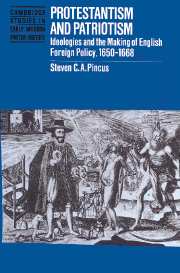Book contents
- Frontmatter
- Contents
- Acknowledgments
- List of abbreviations
- 1 Introduction
- Part I The rod of the Lord: ideology and the outbreak of the First Anglo-Dutch War
- Part II To unite against the common enemy: the 1654 Treaty of Westminster and the end of apocalyptic foreign policy
- 5 Historiographical overview
- 6 The causes of the war stated
- 7 Peace proposed
- 8 Political upheavals and ideological divisions
- 9 The rejection of apocalyptic foreign policy
- 10 The Protectorate's new foreign policy
- Part III Popery, trade, and universal monarchy: ideology and the outbreak of the Second Anglo-Dutch War
- Part IV The Medway, Breda, and the Triple Alliance: the collapse of Anglican Royalist Foreign Policy
- Conclusion
- Bibliography
- Index
- Titles in the series
5 - Historiographical overview
Published online by Cambridge University Press: 01 October 2009
- Frontmatter
- Contents
- Acknowledgments
- List of abbreviations
- 1 Introduction
- Part I The rod of the Lord: ideology and the outbreak of the First Anglo-Dutch War
- Part II To unite against the common enemy: the 1654 Treaty of Westminster and the end of apocalyptic foreign policy
- 5 Historiographical overview
- 6 The causes of the war stated
- 7 Peace proposed
- 8 Political upheavals and ideological divisions
- 9 The rejection of apocalyptic foreign policy
- 10 The Protectorate's new foreign policy
- Part III Popery, trade, and universal monarchy: ideology and the outbreak of the Second Anglo-Dutch War
- Part IV The Medway, Breda, and the Triple Alliance: the collapse of Anglican Royalist Foreign Policy
- Conclusion
- Bibliography
- Index
- Titles in the series
Summary
The English, convinced that God had shown his favor towards them in demolishing the tyranny of Charles I and subsequently in defeating the invasion of his son at the head of a Scottish army, could not help but place a special significance on their struggle with the Dutch. The English could be certain that this was no minor squabble, after all the Dutch naval war hero Martin Van Tromp had proclaimed that “no quarter shall be given to the English and that [the Dutch] will revenge themselves with fire and sword.” Indeed, the entire Dutch navy had “taken an oath and protestation to live and die together, and to fight it out to the last man.” Consequently the importance of the war against the Dutch was clear to a wide variety of observers. “Many eyes are on our breach with Holland,” noted the Essex clergyman Ralph Josselin, “God is shaking the earth and he will do it.” “So terrible a sea-fight hath not been heard of in the remembrance of any man, ” commented one pamphleteer after a minor skirmish in August 1652, “the discolored sea showing the effects of their wrath. ” After the battle of Portland in February 1653, observers had more reason to express wonder at the scale and ferocity of the conflict. “The battle of Lepanto was not comparable to this,” thought the Canary merchant John Paige; “there was never the like battle fought upon the salt waters since the creation of the world.”
- Type
- Chapter
- Information
- Protestantism and PatriotismIdeologies and the Making of English Foreign Policy, 1650–1668, pp. 83 - 86Publisher: Cambridge University PressPrint publication year: 1996
- 1
- Cited by



